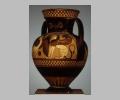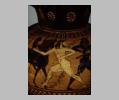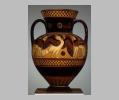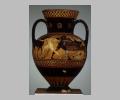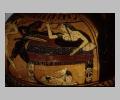| Collection: | Paris, Musée du Louvre |
| Summary: | Side A: Tydeus attacking Ismene, Periklymenos fleeing |
| Ware: | Corinthian |
| Painter: | Name vase of the Tydeus Painter |
| Context: | From Caere |
| Date: | ca. 560 BC - ca. 550 BC |
| Dimensions: | H. 0.32 m |
| Primary Citation: | |
| Shape: | Amphora |
| Ceramic Phase: | Late Corinthian |
| Region: | Etruria |
| Period: | Archaic |
Decoration Description:
Side A: Tydeus, painted in black and striding right in the center of the scene, attacks Ismene with a sword which he wields in his right hand. He is naked, with only a headband and a strap over his right shoulder from which his sword scabbard hangs on the left. Ismene is rendered in white, still bedded in her kline, naked with her lower half protected by a red and black cover. She raises her right hand in alarm as Tydeus grasps her forearm. Her hair is long and braided, held back by a headband. Under her kline a dog lies, painted white, his head raised alert. Behind Tydeus, Ismene's lover Periklymenos flees from the attack. He is also painted in white, naked and bearded, with a headband. On the far left Klytos sits astride his horse, both figures in black. He is wearing a short-sleeved red chiton, and he holds his spear upright in his left hand. His horse's mane is red. The scene is bordered above by alternating black and red tongues, below by a pattern of black circles connected in a grid.
Side B: A white siren with spread black and red wings sits between two white sphinxes, also with black and red wings. A single rosette appears between the righthand sphinx and the siren. The upper and lower borders to the scene are the same as on side A.
The neck on both sides is decorated with large red rosettes with white petals. Below the main panels is a broad black zone, with a flame pattern reaching up to meet it from the base.
Inscriptions: All figures on side A are labelled in Corinthian letters: from left,
Sources Used:
